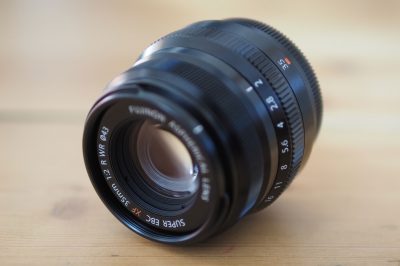Fujifilm XF 35mm f2 review
-
-
Written by Gordon Laing
In depth
The Fujifilm XF 35mm f2 is a fairly bright prime lens delivering standard coverage when mounted on one of the company’s X-series bodies. Announced in October 2015, it’s the second 35mm lens for the X-system, joining the original XF 35mm f1.4 which helped launch the system almost four years earlier.
Both lenses deliver 52.5mm equivalent coverage when mounted on an X-series body, providing the classic general-purpose standard field of view that’s equally at home with landscapes and interiors as it is with portraits and group shots. The XF 35mm f2 may have a focal ratio that’s one stop slower than the original 35mm f1.4, but like other recent Fujifilm primes, it boasts weather resistance.
As a newer lens, the XF 35mm f2 also enjoys faster focusing and Fujifilm’s additionally taken the opportunity to equip it with nine aperture blades compared to seven on the f1.4 version. So despite initially looking like a smaller, more budget oriented standard prime, the new XF 35mm f2 actually enjoys a number of key advantages over the original model. Then there’s the question of image quality with almost four years between them. With so many questions, I simply had to test the new XF 35mm f2 alongside the original XF 35mm f1.4, allowing me to directly compare them for quality at close and long ranges, measure their focusing speeds and crucially see how they handle depth-of-field and rendering of out-of-focus areas. Read on for my in-depth review where I’ll help you choose the right 35mm lens for your Fuji system!
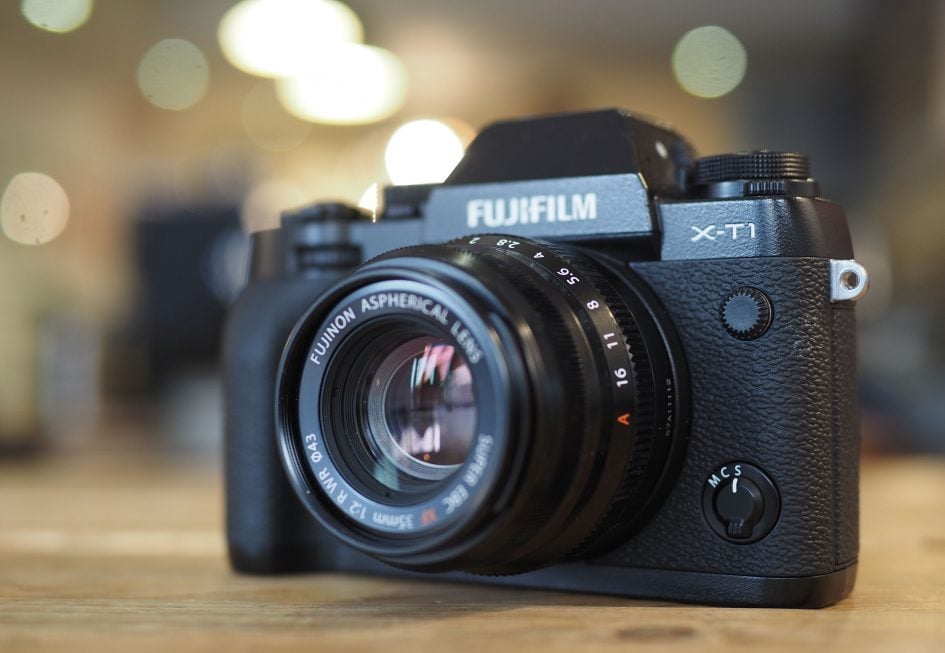
Fujifilm XF 35mm f2 design and build quality
The XF 35mm f2 employs a tapered-design where the barrel becomes narrower towards the front. It starts off at around 60mm in diameter at the lens mount, but gradually shrinks to around 45mm at the front, allowing it to accommodate a fairly modest 43mm diameter filter, compared to 52mm on the older XF 35mm f1.4.
Technically the diameter – even at the widest point – makes the XF 35mm f2 the narrowest XF lens to date, but while the tapered design gives it the impression of being visibly smaller than the XF 35mm f1.4, place them side-by-side and there’s not a huge difference. The XF 35mm f2 is on the left below, and the XF 35mm f1.4 on the right.
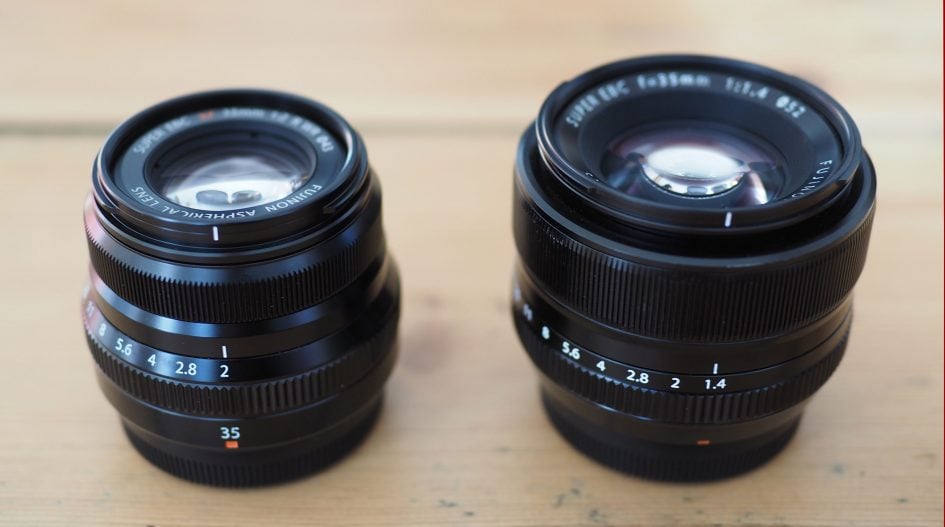
The older lens measures 65mm in diameter for most of its 50mm length (from the mount plate) and weighs 187g, while the newer lens measures 60mm in diameter at its widest point and 45mm to the mount, and weighs 170g. So once again while the newer lens is smaller and lighter than the f1.4 version, it doesn’t make that much difference in your bag or when mounted on a body.
In terms of build quality, both lenses feel solid and well-constructed, but the new model features a rubber gasket, giving it weather-sealing on the mount with equally-sealed bodies. Fit it on an XT1 and you’ll enjoy a weather-sealed combination, a key advantage over the original lens. As a side-note I’m really pleased to see Fujifilm equipping its latest lenses with weather resistance and when I mentioned this to one of their Japanese managers, I was informed it was the plan to implement weather-sealing on all (presumably non-budget) future lenses. It was also suggested there could be new weather-sealed versions of existing lenses in the range.
The XF 35mm f2 barrel employs two rings: a manual aperture dial at the lens mount-end of the barrel with numbered focal ratios from f2 to f16 in 0.3 EV increments followed by A, and a narrow manual focusing ring towards the front of the barrel. The focusing ring turns freely and doesn’t employ the push-pull operation of some higher-end lenses like the XF 16mm f1.4. The focusing ring on the XF 35mm f2 spins much more smoothly than the ring on the older XF 35mm f1.4, and unlike that model, focusing takes place internally without extending the barrel. The manual focusing rings on both lenses, like all in the Fuji X-system, are motor-assisted.
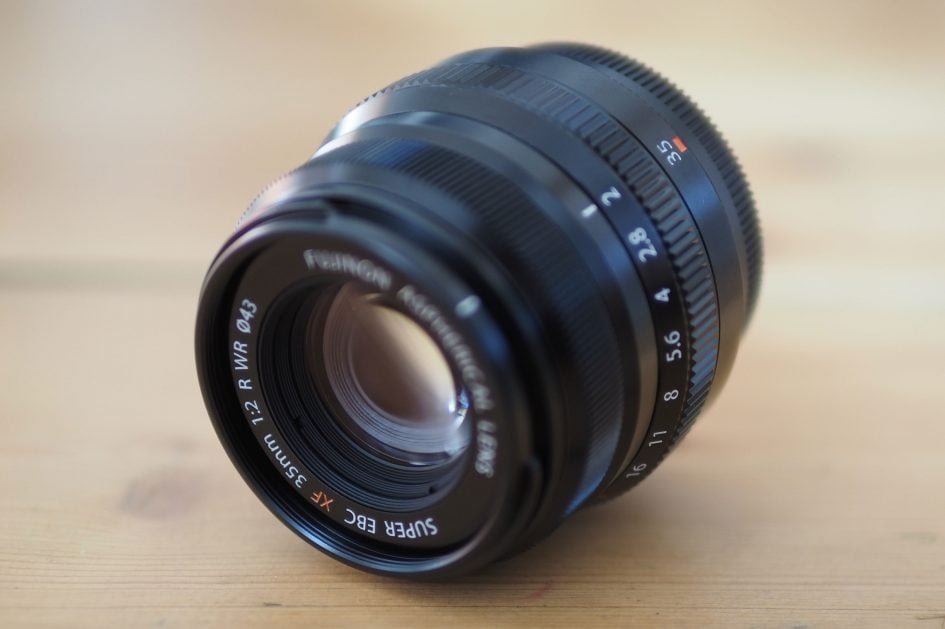
In terms of autofocus these two lenses literally represent the evolution of the X-system from launch. The XF 35mm f1.4 was one of the very first lenses available in the X-mount and even when fitted on the latest bodies it continues to focus fairly slowly and quite audibly – indeed you can even feel the motors grinding-away as you half-press the shutter. In contrast, the new XF 35mm f2 is not just visibly faster and more confident (typically locking-on in half a second), but it operates in virtual silence. It’s amazing to compare them side-by-side and see (not to mention hear and feel) how far Fujifilm has come since the launch of the system.
If you can exploit the faster focusing for street or candid portraits, you’ll really appreciate the speed of the XF 35mm f2 over the f1.4 model, and it’s also a great deal more usable for continuous autofocus.
A final note on lens hoods. Fujifilm supplies the XF 35mm f2 with a very small hood, which keeps the overall size down and maintains a discreet appearance but understandably offers minimal protection. If you fancy something more substantial, there’s an optional metal hood available, but it will in turn occupy more space in your bag and look less discreet in use.
Fujifilm XF 35mm f2 optical construction
In terms of optical construction, the XF 35mm f2 employs nine elements in six groups with two aspherical elements, and nine aperture blades. The minimum focusing distance is 35cm and like all Fujifilm primes to date, there’s no optical stabilisation.
The XF 35mm f2 delivers standard coverage equivalent to 52.5mm when mounted on an X-series body. This is the classic general-purpose field of view which can turn itself to pretty much any situation. If there’s one lens everyone needs in their collection, it’s a 50mm equivalent.
As you know by now, Fujifilm offers two 35mm lenses, the original f1.4 model and the latest f2 version. At first glance it would be easy to assume they share exactly the same coverage and move onto comparing other differences, but I never take anything for granted. So here’s a shot taken from the same position with both lenses, where it’s clear the new model is capturing a fractionally wider field of view in practice when focused at infinity. I mention this more out of interest than anything else!

Above left: XF 35mm f2 coverage, above right: XF 35mm f1.4 coverage
The closest focusing distance is 35cm compared to 28cm on the f1.4 model, which should mean the new lens isn’t quite as good for close-ups. To see what difference it makes in practice I photographed a ruler at the closest focusing distance of each lens to literally reveal what you can expect. As you can see below, the XF 35mm f2 can capture subjects as small as 148mm across the frame compared to 133mm on the XF 35mm f1.4.

Above left: XF 35mm f2 at closest focusing distance, above right: XF 35mm f1.4 at closest focusing distance
While it’s easy to be influenced by specifications including the closest focusing distance, I didn’t find it held me back particularly when shooting with the XF 35mm f2 compared to the f1.4 model. Neither can get really close to a subject, so if macro shooting’s your thing, go for a dedicated macro lens. But if the subject isn’t too small, you can still achieve some nice results. Here’s a couple of shots close to the minimum focusing distance.

Above: 1/150, f2, 400 ISO, 35mm

Above: 1/125, f2, 400 ISO, 35mm
The most obvious difference in specification between the new and old XF 35mm lenses is of course their focal ratio: f2 on the latest model versus f1.4 on the original one. This means the XF 35mm f1.4 is one stop faster than the f2 version, allowing it to gather twice as much light and deploy half the ISO or a shutter twice as fast under the same lighting conditions.
While this is useful, especially considering neither has optical stabilisation, the other important impact of focal ratio is the effect it has on the depth-of-field, with larger apertures delivering greater potential blurring. Here the f1.4 lens should enjoy a visible advantage over the f2 version, but to see how much I made a number of comparisons. First is a close-up shot of a beer bottle in the lovely Bison Beer shop in Brighton. I fitted each lens to my XT1 body, mounted on a tripod so that the subject distance didn’t vary. Since the older XF 35mm f1.4 has a slightly longer actual focal length, it captured a slightly tighter field of view here when both were at the same distance.

Above right, XF 35mm f1.4 at f2

Above left: XF 35mm f2 at f2, above right, XF 35mm f1.4 at f2

Above left: XF 35mm f2 at f2.8, above right, XF 35mm f1.4 at f2.8

Above left: XF 35mm f2 at f4, above right, XF 35mm f1.4 at f4
As you can see in the comparisons above, the XF 35mm f1.4 is delivering a visibly shallower depth-of-field than the XF 35mm f2 when both are set to their maximum apertures, but it may not represent quite as big a difference as you expected. Let’s take a closer look at the area of maximum blurring behind the main subject when both lenses are at their maximum apertures.
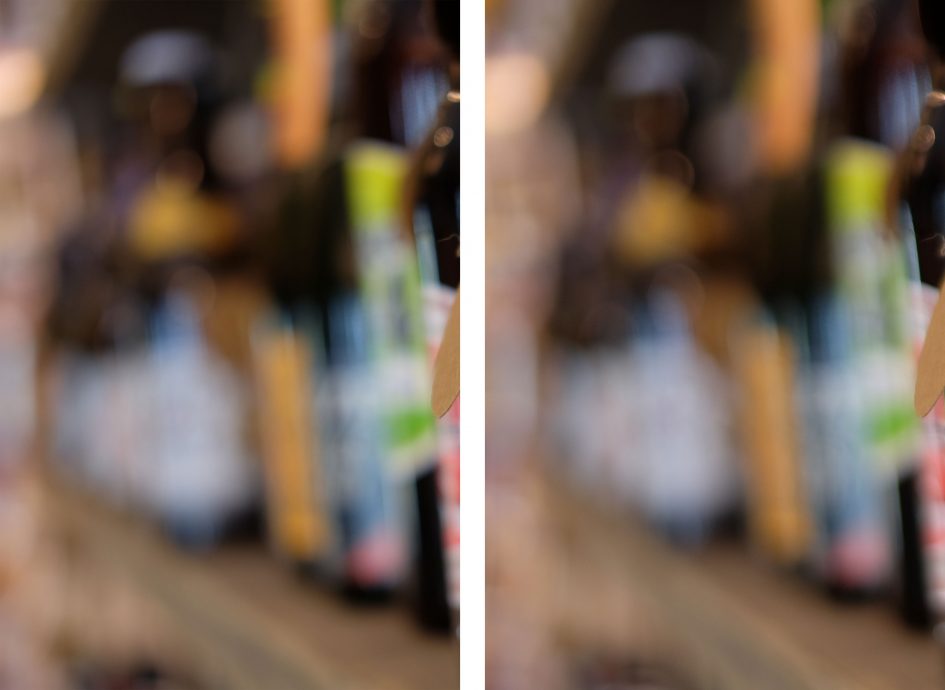
Above left: XF 35mm f2 at f2 (crop), above right: XF 35mm f1.4 at f1.4 (crop)
In the crops above, you can see the rendering from the 35mm f1.4 is a tad creamier with slightly larger blurring effects, but again it’s quite subtle and may not even drive bokeh addicts towards the older lens.
One of the best tests for bokeh is to see how a lens renders out-of-focus point sources of light, and there’s few things better than festive fairy lights. So for my next comparison I again mounted my XT1 on a tripod and photographed a subject at close range with some fairy lights in the background. Keep a close eye on the shape of the blurred blobs, especially as the aperture closes on each lens.
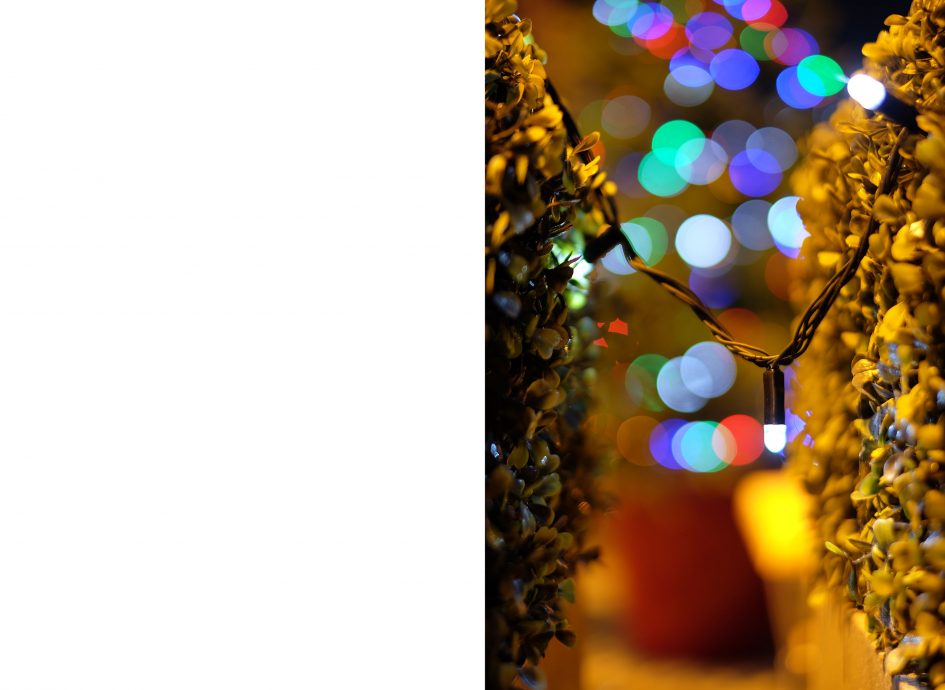
Above right, XF 35mm f1.4 at f1.4
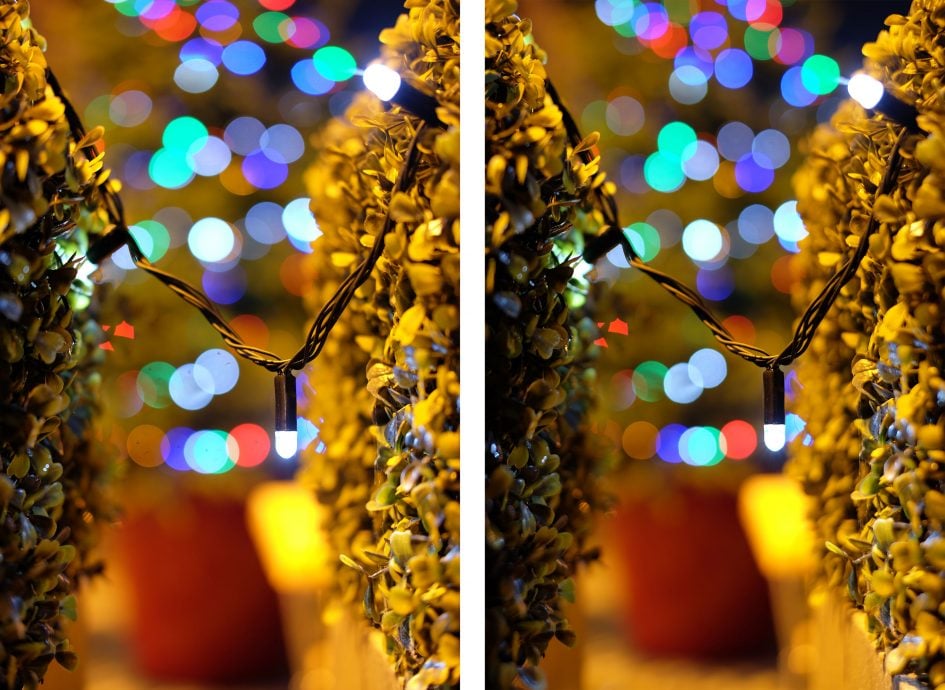
Above left: XF 35mm f2 at f2, above right, XF 35mm f1.4 at f2
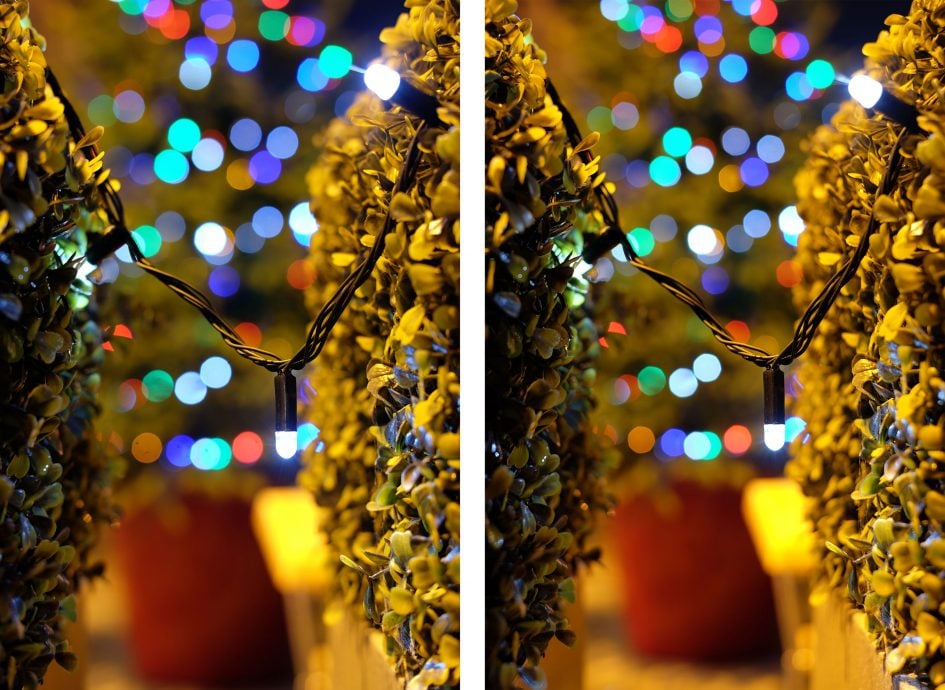
Above left: XF 35mm f2 at f2.8, above right, XF 35mm f1.4 at f2.8
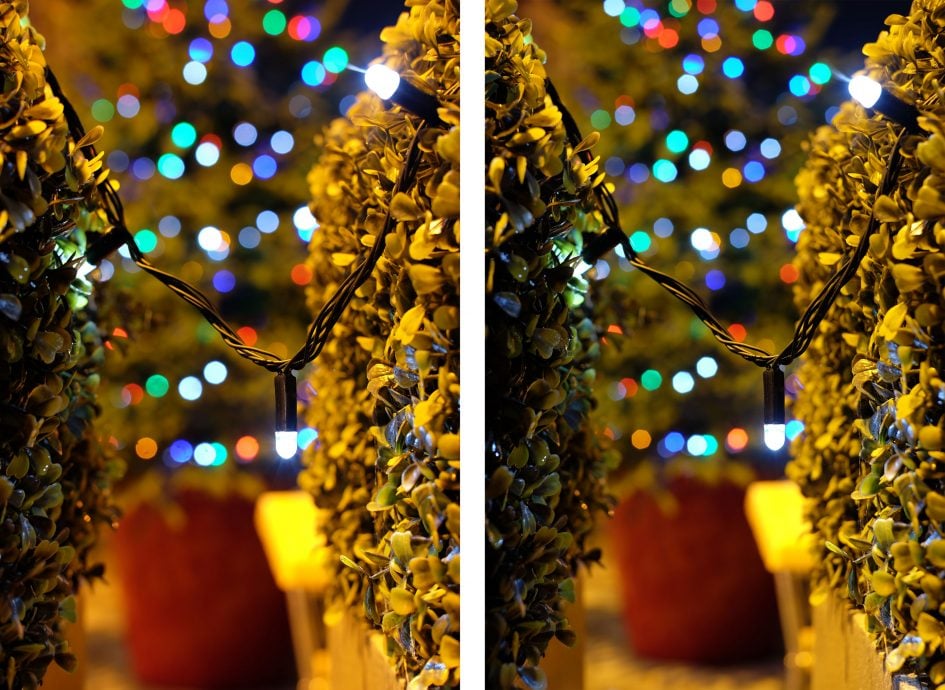
Above left: XF 35mm f2 at f4, above right, XF 35mm f1.4 at f4
As you can see from the full images above, both lenses render point sources of light as squashed discs towards the edges of the frame at their maximum apertures; while this ‘cats-eye’ optical effect is an aberration, some people like it. If you don’t, simply close the aperture on either lens by one stop and the shape will become more rounded.
As you do close the aperture on a lens down though, another optical effect comes into play, and that’s the number and shape of the actual aperture blades. If they can make a perfect circle, then that will be reflected in the shape of the blurring. But more commonly the aperture shape isn’t perfectly circular and this in turn has an impact on the shape of the blurring. Most obviously the number of blades turns blurred blobs into geometric shapes sharing the same number of sides: nine on the XF 35mm f2 versus seven on the XF 35mm f1.4.
Judging from the images above, I’d say the impact of the aperture blades is more visible on the XF 35mm f1.4 which renders fairly defined seven-sided shapes as you close it down. In comparison, the XF 35mm f2 maintains a more circular shape, thanks partly to having more blades, although it’s still not perfectly round. Again there’s no correct solution here, only one which you personally prefer.
Aperture blades are also responsible for another optical artefact that can be desirable: as the aperture closes, diffraction can cause very bright lights to ‘grow’ spikes. The smaller the aperture, the longer and better-defined the spikes. The effect works best on small and bright sources of light, such as distant streetlamps on a city skyline at night, or the Sun in a clear sky with minimal haze.
The number of spikes is double the number of aperture blades, so the new XF 35mm f2 will have 18, while the original XF 35mm f1.4 will have 14. To compare how they look in practice, I shot the following scene at night at every aperture.
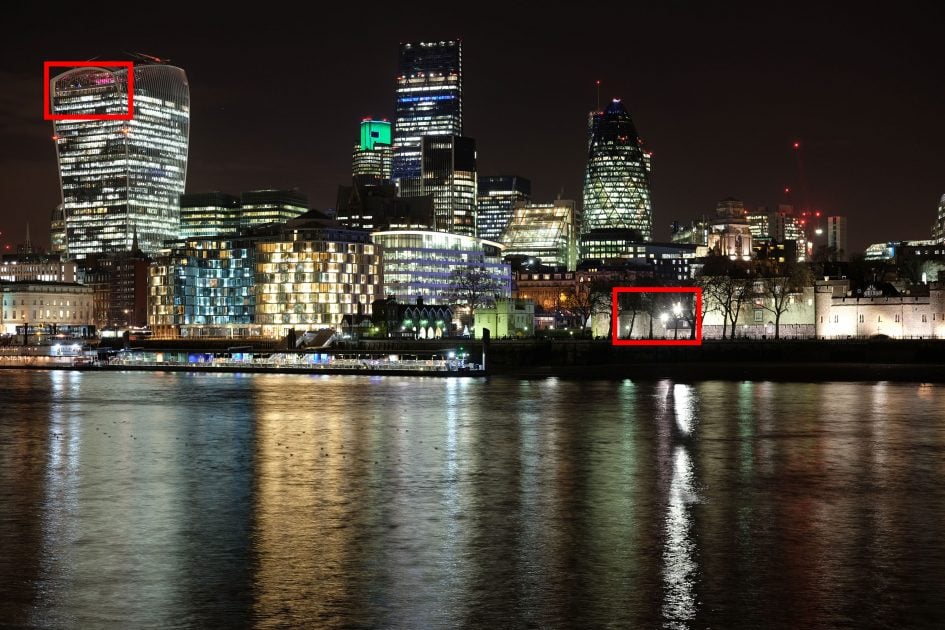
Above: Fujifilm XF 35mm f2 (52.5mm equivalent)
Below I’ve presented crops of the most notable diffraction spikes from both lenses at f11 and the minimum aperture of f16. As you can see, the spikes are better-defined at f16 than f11 on both lenses, although there’s a trade-off with overall contrast reducing at the minimum apertures.

Above left: XF 35mm f2 at f11, above right, XF 35mm f1.4 at f11

Above left: XF 35mm f2 at f16, above right, XF 35mm f1.4 at f16
The big difference between each lens here regards the number and definition of the spikes. The new XF 35mm f2 has the most spikes – 18 in all – but they’re not as crisp as the XF 35mm f1.4. This is the inevitable trade-off due to the shape of the blades. If you want sharp, defined spikes under these conditions, you may have to accept a more defined geometric shape on blurred point sources of light as seen on the previous test. Once again there’s no right or wrong here, just a personal preference of how a lens handles certain conditions.
Now it’s time to check out how the lens performs in terms of sharpness across the frame! Check out my Fuji XF 35mm f2 sharpness results, or skip to my Fuji XF 35mm f2 sample images or back to my verdict! My sharpness page also includes a full set of results for the night scene above both to see the effect of different aperture values on the spikes, along with the sharpness and correction in the corners.




